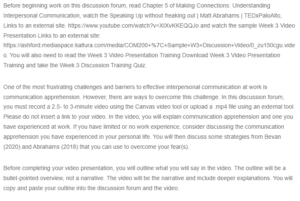Communication Apprehension Video Presentation
Presentation outline
Introduction
According to Bevan (2020), communication apprehension refers to stress and fear related to any communication form, hypothetical or real, including hesitation and stage fright. There are two types of communication apprehension: communication apprehension and state communication apprehension. Typically, apprehension occurs when fear or anxiety arises from an individual’s experience when communicating or planning to communicate with another person (Loureiro et al., 2020). Thus, a psychological reaction prompts our worry about what others will think of us. Hire our assignment writing services in case your assignment is devastating you.
Body
Experience
- I experienced communication apprehension in the past at the workplace. I happened to commit an error during the work that caused the company printer to encounter problems and finally fail. For some time, my senior used to ask me what happened, and I used to dodge that question. However, he summoned me to a talk regarding the issue.
- During the conversation, I experienced communication apprehension. I experienced faster heartbeats alongside sweating that could hardly allow me to express my ideas clearly. I even forgot some of the statements that I had planned to say.
- It turned out interesting that my senior had no problem with what had happened and wanted to find a way to help me. He acknowledged my hard-working behavior and gave me his commitment to helping me grow professionally while at the workplace.
- There are four types of communication apprehension described by Subekti (2020). I experience dyadic communication apprehension, such as in the case presented above. The apprehension results from wondering what the other person is thinking of me.
Strategies to overcome communication apprehension
- Suggestions were made in Bevan’s (2020) section 5.4 regarding handling communication apprehension. From the case, I think preparing before communication and practicing what to say will be the best strategies to overcome my communication apprehension.
- Other strategies can be considered in the Speaking Up Without Freaking Out YouTube video by Matt Abrahams (2018). The strategies include being yourself, taking a deep breath, and holding something cold to reduce sweating.
Gains from the above strategies
- Better communication with others
- Improved self-confidence in speaking
Conclusion
In conclusion, communication apprehension is a fear many face; for example, when I was summoned, I faced dyadic communication apprehension. But on the brighter side, communication apprehension can be overcome in many ways, for example, by proper preparation before giving a talk or communicating. Secondly, one could take deep breaths or hold something cold to avoid sweating before a talk. Subsequently, by applying these strategies, one could become a better communicator since it improves self-confidence. Professionally, learning to be a good communicator is crucial because it makes it simpler to win the confidence and trust of colleagues, clients, and even family members.
References
Bevan, J. L. (2020). Making connections: Understanding interpersonal communication (3rd ed.)
Loureiro, M., Loureiro, N., & Silva, R. (2020). Differences of gender in oral and written communication apprehension of university students. Education Sciences, 10(12), 379.
Matt Abrahams (2018). Speaking Up Without Freaking Out. Retrieved from https://www.youtube.com/watch?v=XIXvKKEQQJo
Subekti, A. S. (2020). Self-perceived communication competence and communication apprehension: A study of Indonesian college students. EduLite: Journal of English Education, Literature and Culture, 5(1), 14-31.
ORDER A PLAGIARISM-FREE PAPER HERE
We’ll write everything from scratch
Question
Before beginning work on this discussion forum, read Chapter 5 of Making Connections: Understanding Interpersonal Communication, watch the Speaking Up without freaking out | Matt Abrahams | TEDxPaloAlto, Links to an external site. https://www.youtube.com/watch?v=XIXvKKEQQJo and watch the sample Week 3 Video Presentation Links to an external site: https://ashford.mediaspace.kaltura.com/media/COM200+%7C+Sample+W3+Discussion+Video/0_zu150cgu.video. You will also need to read the Week 3 Video Presentation Training Download Week 3 Video Presentation Training and take the Week 3 Discussion Training Quiz.

Communication Apprehension Video Presentation
One of the most frustrating challenges and barriers to effective interpersonal communication at work is communication apprehension. However, there are ways to overcome this challenge. In this discussion forum, you must record a 2.5- to 3-minute video using the Canvas video tool or upload a .mp4 file using an external tool. Please do not insert a link to your video. In the video, you will explain communication apprehension and one you have experienced at work. If you have limited or no work experience, consider discussing the communication apprehension you have experienced in your personal life. You will then discuss some strategies from Bevan (2020) and Abrahams (2018) that you can use to overcome your fear(s).
Before completing your video presentation, you will outline what you will say in the video. The outline will be a bullet-pointed overview, not a narrative. The video will be the narrative and include deeper explanations. You will copy and paste your outline into the discussion forum and the video.
In your video and outline, you must
Explain communication apprehension, using and citing your textbook.
Describe a time you experienced a specific type of communication apprehension identified in your textbook (dyadic, group or meeting, or public speaking) in the workplace.
Explain two specific strategies you can use to overcome your communication apprehension based on advice from Chapter 5 and the Speaking Up Without Freaking Out | Matt Abrahams | TEDxPaloAltoLinks to an external site.https://www.youtube.com/watch?v=XIXvKKEQQJo
Explain what you will gain from making these improvements.
Use the Canvas video posting system to Post your outline and a video.
Remember, you will be required to mention your textbook and the Speaking Up Without Freaking Out | Matt Abrahams | TEDxPaloAlto Links to an external site. Video in your presentation. Be sure to use their names in your presentation.
If you have a disability that prevents you from speaking in a video or hearing the videos of others, please let your instructor know, and they will provide you with an alternative for completing this assignment.
For tips on recording a good video and other advice, see the “Resources” box in the upper right-hand corner.

